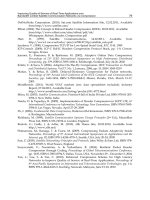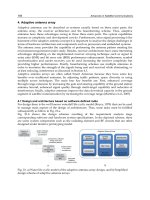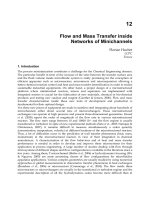Resource Management in Satellite Networks part 7 docx
Bạn đang xem bản rút gọn của tài liệu. Xem và tải ngay bản đầy đủ của tài liệu tại đây (194.94 KB, 10 trang )
Chapter 1: INTRODUCTION TO SATELLITE COMMUNICATIONS 37
An example of the first method is when cross-layer signaling is provided
through the SI-SAP to connect the management of the layer 3 queues with
that of layer 2 ones (e.g., information regarding the length of the layer 2
queue, used by layer 3). This mechanism is important to support QoS. In
particular, the SI layer requests layer 2 queue status information through a
C-plane primitive (namely, a REQUEST primitive) and the SD layer answers
by means of another C-plane primitive (namely, a CONFIRM primitive). As
already stated, it is possible that BPM manages this information exchange.
Finally, an example of cross-layer information exchange not involving the
use of SI-SAP is that between layer 1 and layer 2. Such signalling can be used
for the MODCOD switching of DVB-S2. In such case, a C-plane primitive is
used to request, to notify or to update information (respectively REQUEST,
INDICATION, and RESPONSE primitives).
1.7 Conclusions
Satellite systems are an attractive solution to provide multimedia commu-
nication services in wide areas of the Earth, also reaching those regions
that lack of terrestrial telecommunication infrastructures. In this framework,
this Chapter has provided an introduction to the features of satellites for
communications, including: orbit types (GEO, MEO, LEO), atmospheric
attenuation phenomena and related packet losses, multiple access schemes
and the air interfaces of main interest for this book (i.e., S-UMTS and
DVB-S/-S2/-RCS).
In this Chapter, a special attention has been also given to the basic aspects
(characteristics, constraints, etc.) related to the management of satellite
resources in S-UMTS and DVB-S/-S2/-RCS systems. Such information will
be essential in the study of the resource management schemes that will be
carried out in the next Chapters, each addressing these techniques from a
different prospective. This Chapter has also provided three main scenarios
with numerical details that will be adopted for numerical evaluations in this
book.
Within the research community a range of issues are currently being
investigated that are expected to improve the efficiency and the capacity
of satellite communication systems. Towards this aim, this Chapter has
introduced the novel cross-layer approach for the optimized design of the
satellite air interface; many techniques based on this new paradigm will be
described throughout this book.
References
[1] A. Andreadis, G. Giambene. Protocols for High-Efficiency Wireless Networks.
Kluwer Academic Publishers, Norwell, MA, USA, 2003.
[2] R. E. Sheriff, Y. F. Hu. Mobile Satellite Communication Network. Wiley & Sons,
Ltd, Baffins Lane, Chichester, England, 2001.
[3] L. Harte, S. Kellogg, R. Dreher, T. Schaffnit. The Comprehensive Guide
to Wireless Technologies: cellular, PCS, paging, SMR, and satellite.Apdg
Publishing, 2000.
[4] B. Elbert. The Satellite Communication. Ground Segment and Earth Station
Handbook. Artech House, Norwood, MA, USA, 2001.
[5] A. Jamalipour. Low Earth Orbital Satellites for Personal Communication
Network. Artech House, Norwood, MA, USA, 1998.
[6] G. Maral, M. Bousquet. Satellite Communications Systems.3
rd
Edition, John
Wiley & Sons, Chichester, England, 1998.
[7] S.L.Kota,K.Pahlavan,P.A.Lepp¨anen. Broadband satellite Communications
for Internet Access. Kluwer Academic Publishers. New York, 1994.
[8] Web site with URL:
/>[9] Web sites on planned or operational satellite communication systems with
URLs:
/> /> /> /> /> /> />space.asp.
[10] P. Barsocchi, N. Celandroni, E. Ferro, F. Davoli, G. Giambene, A. Gotta, F.
J. Gonz´alez Casta˜no, J. I. Moreno, P. Todorova, “Radio Resource Management
Across Multiple Protocol Layers in Satellite Networks: a Tutorial Overview”,
International Journal of Satellite Communications and Networking, Vol. 23, No.
5, pp. 265-305, September/October 2005.
[11] U. Vornefeld, C. Walke, B. Walke, “SDMA Techniques for Wireless ATM”,
IEEE Communications Magazine, Vol. 37, No. 11, pp. 52-57, November 1999.
40 Giovanni Giambene
[12] J. Gilderson, J. Cherkaoui, “Onboard Switching for ATM via Satellite”, IEEE
Communications Magazine, Vol. 35, No. 7, pp. 66-70, July 1997.
[13] ETSI, “Digital Video Broadcasting (DVB); Framing Structure, Channel Coding
and Modulation for 11/12 GHz Satellite Services”, EN 300 421, V1.1.2, (1997).
[14] ETSI, “Digital Video Broadcasting (DVB); Interaction Channel for Satellite
Distribution Systems”, EN 301 790, V1.3.1 (2002-11).
[15] ETSI, “Digital Video Broadcasting (DVB); Interaction Channel for Satellite
Distribution Systems; Guidelines for the use of EN 301 790”, TR 101 790, V1.2.1,
(2003).
[16] ETSI, “Digital Video Broadcasting (DVB); Second Generation Framing
Structure, Channel Coding and Modulation Systems for Broadcasting,
Interactive Services, News Gathering and other Broadband Satellite
Applications (DVB-S2)”, EN 302 307.
[17] ETSI, “Satellite Earth Stations and Systems (SES); Satellite Component of
UMTS/IMT2000; G-family; Part 1: Physical Channels and Mapping of Transport
Channels into Physical Channels (S-UMTS-A 25.211)”, TS 101 851-1.
[18] ETSI, “Satellite Earth Stations and Systems (SES); Satellite Component
of UMTS/IMT2000; G-family; Part 2: Multiplexing and Channel Coding
(S-UMTS-A 25.212)”, TS 101 851-2.
[19] ETSI, “Satellite Earth Stations and Systems (SES); Satellite Component of
UMTS/IMT2000; G-family; Part 3: Spreading and Modulation (S-UMTS-A
25.213)”, TS 101 851-3.
[20] ETSI, “Satellite Earth Stations and Systems (SES); Satellite Component of
UMTS/IMT2000; G-family; Part 4: Physical Layer Procedures (S-UMTS-A
25.214)”, TS 101 851-4.
[21] 3GPP, “Technical Specification Group Services and System Aspects, Iu
Principles”, 3G TR 23.930.
[22] P. Taaghol, B. G. Evans, E. Buracchini, R. De Gaudenzi, G. Gallinaro, J. Ho
Lee, C. Gu Kang, “Satellite UMTS/IMT2000 W-CDMA Air Interfaces”, IEEE
Communications Magazine, Vol. 37, No. 9, pp. 116-126, September 1999.
[23] H. Skinnemoen, A. Jahn, J. Kenyon, A. R. Noerpel, “A Comparative Study of
DVB-RCS, IPOS and DOCSIS for Satellite”, in Proc.ofthe23
rd
AIAA&Ka
Band Joint Conference, Rome, September 25-28, 2005.
[24] M. Marchese, M. Mongelli, “On-Line Bandwidth Control for Quality of
Service Mapping over Satellite Independent Service Access Points”, Computer
Networks, Vol. 50, No. 12, pp. 1885-2126, August 2006.
[25] ETSI, “Satellite Earth Stations and Systems (SES); Broadband Satellite
Multimedia; Services and Architectures; BSM Traffic Classes”, TS 102 295,
V1.1.1, February 2004.
[26] The special issue of the International Journal of Satellite Communications and
Networking on the DVB-S2 standard for broadband satellite systems, 2004.
[27] D. Breynaert, M. d’Oreye de Lantremange, “Analysis of the Bandwidth
Efficiency of DVB-S2 in a Typical Data Distribution Network”, in Proc. of
CCBN2005, Beijing, March 21-23, 2005.
[28] A. Morello, V. Mignone, “DVB-S2 - Ready for Lift off”, EBU Technical Review,
October 2004.
[29] E. Lutz, D. Cygan, M. Dippold, F. Dolainsky, W. Papke, “The Land Mobile
Satellite Communication and Recording, Statistics and Channel Model”, IEEE
Transactions on Vehicular Technology, Vol. 40, No. 2, pp. 375-386, May 1991.
Chapter 1: INTRODUCTION TO SATELLITE COMMUNICATIONS 41
[30] C. Blondia, O. Casals, “Performance Analysis of Statistical Multiplexing of
VBR Sources”, in Proc. of INFOCOM’92, pp. 828-838, 1992.
[31] A. H. Aghvami, A. E. Brand, “Multidimensional PRMA with Priorized Bayesan
Broadcast”, IEEE Transactions on Vehicular Technology, Vol. 47, No. 4, pp.
1148-1161, November 1998.
[32] ETSI, “Satellite Earth Stations and Systems (SES); Broadband Satellite
Multimedia; Services and Architectures”, TR 101 984 V1.1.1 (2002-11).
[33] ETSI, “Satellite Earth Stations and Systems (SES); Broadband Satellite
Multimedia (BSM) Services and Architectures; Functional Architecture for IP
Interworking with BSM Networks”, TS 102 292 V1.1.1 (2004-02).
[34] ETSI, “Satellite Earth Stations and Systems (SES); Broadband Satellite
Multimedia; IP over Satellite”, TR 101 985 V1.1.2 (2002-11).
[35] ETSI, “Satellite Earth Stations and Systems (SES); Broadband Satellite Mul-
timedia (BSM) Services and Architectures: Security Functional Architecture”,
TS 102 465 V0.4.2 (2006-01).
[36] ETSI, “Satellite Earth Stations and Systems (SES); Broadband Satellite
Multimedia (BSM) Services and Architectures: QoS Functional Architecture”,
TS 102 462 V1.1.1 (2006-12).
[37] ETSI, “Satellite Earth Stations and Systems (SES); Broadband Satellite
Multimedia (BSM). Common air interface specification; Satellite Independent
Service Access Point (SI-SAP)”, TS 102 357 V1.1.1 (2005-05).
[38] 3GPP, “Technical Specification Group Radio Access Network, Improvement of
RRM Across RNS and RNS/BSS”, TR 25.881, 2001 (release 5).
[39] G. Giambene, S. L. Kota, “Cross-Layer Protocol Optimization for Satellite
Communications Networks: a Survey”, International Journal of Satellite
Communications and Networking, Vol. 24, pp. 323-341, September/October
2006.
[40] Q. Wang, M A. Abu-Rgheff, “Cross-Layer Signaling for Next-Generation
Wireless Systems”, in Proc. of the IEEE Wireless Communications and
Networking Conference (WCNC), New Orleans, USA, March 16-20, 2003.
[41] M. Conti, J. Crowcroft, G. Maselli, G. Turi, “A Modular Cross-Layer
Architecture for Ad Hoc Networks”, Chapter 1 in Handbook on Theoretical and
Algorithmic Aspects of Sensor, Ad Hoc Wireless, and Peer-to-Peer Networks,
Jie Wu (editor), CRC Press, New York, 2005.
[42] G. Carneiro, J. Ruela, M. Ricardo, “Cross-Layer Design in 4G Wireless
Terminals”, IEEE Wireless Communications Magazine, Vol. 11, No. 2, pp. 7-13,
April 2004.
[43] V. Vardhan, D. G. Sachs, W. Yuan, A. F. Harris, S. V. Adve, D. L. Jones,
R. H. Kravets, K. Nahrstedt, “GRACE: A Hierarchical Adaptation Framework
for Saving Energy”, Computer Science, University of Illinois Technical Report
UIUCDCS-R-2004-2409, February 2004.
[44] ETSI, “Satellite Earth Stations and Systems (SES); Broadband Satellite
Multimedia; IP Interworking over satellite; Performance, Availability and
Quality of Service”, TR 102 157 V1.1.1 (2003-07).
2
ACTIVITY IN SATELLITE RESOURCE
MANAGEMENT
Editor: Erina Ferro
1
Contributors: Erina Ferro
1
, Franco Davoli
2
, Petia Todorova
3
1
CNR-ISTI - Research Area of Pisa, Italy
2
CNIT - University of Genoa, Italy
3
FhI - Fraunhofer Institute - FOKUS, Berlin, Germany
2.1 Introduction
The efficient exploitation of common resources is an important aspect in
networking, at all protocol layers. In satellite networking, in particular, there
are a number of physical layer issues that have to be addressed in the design
of the system:
• Fading
• Delay spread
• Doppler shift
• Limited spectrum
• Path loss and thermal noise.
Given these issues, the goal of Radio Resource Management (RRM) is to
optimize bandwidth (capacity) utilization and Quality of Service (QoS), in
the presence of traffic flows generated by services with different requirements.
Whenever resources or their modifications are requested, the goal of RRM is
to optimize request satisfaction and, at the same time, to try to maintain a
44 Erina Ferro
certain degree of fairness among all users.
End-user QoS in satellite/terrestrial networks depends on the QoS achieved
at each layer of the network, based on satellite-dependent and independent
functions to be performed at the layer interfaces. The co-operation of all
network layers from top to bottom, as well as of every network element,
is fundamental. Each layer should use efficient technologies and counteract
any performance degradation factors in order to fulfill the user performance
requirements.
As an example of co-operative work, the following actions are considered
in order to optimize system performance.
• Bandwidth-efficient modulation and encoding schemes have to be used at
the physical layer, to improve the Bit Error Rate (BER) and the power
level performance under poor weather conditions, such as heavy rain.
• Guaranteed bandwidth must be provided at the data link layer by using
efficient bandwidth-on-demand multiple access schemes and by studying
the interaction of mechanisms in the presence of congestion and fading.
The provision of a specific bandwidth to be offered by the physical layer
to the upper layers implies the existence of a bandwidth allocation scheme
that shares the available bandwidth among the different user terminals
with different traffic classes.
• The network layer is the lowest layer that deals with source-to-destination
delivery of connection requests (in circuit-switched networks) or packets
(in packet-switched networks); it must know about the topology of the
communication subnet and choose the appropriate paths through it.
Efficient routing policies must be implemented at this level in order to
select paths with the lowest congestion probability. Regarding IP traffic
management, user mobility has to be adequately taken into account.
Hence, network layer protocols must provide a prioritized management
for traffic coming from users that incur in handover phases (such as
in the presence of non-GEO satellites). Additionally, mechanisms for
IP-layer QoS provision have to be adequately mapped to MAC layer RRM
protocols); indeed, besides considering the protocol layering overhead, the
service capacity to network layer queues is provided by MAC queues that,
generally, are not in one-to-one correspondence to the former ones. This
point will be highlighted in some detail in Chapter 8, Section 3.
• At the transport layer, TCP connections, which currently constitute the
bulk of the traffic transferred in the Internet, tend to occupy all the
available bandwidth. The nature of most TCP traffic is asymmetric,
with data flowing in one direction and acknowledgments in the opposite
direction. This translates into different bandwidth requirements from the
sender and the receiver, respectively. Bandwidth assignment and link
quality have a strong impact on the TCP goodput.
• At the application layer, different traffic types (e.g., real-time traffic and
non-real-time traffic) must have specific service level agreements and a
Chapter 2: ACTIVITY IN SATELLITE RESOURCE MANAGEMENT 45
monitoring action has to be performed jointly with the network layer in
order to adaptively modify the service priority.
Several strategies for the optimization of resource management have
been investigated; resource management schemes are strongly related to
the traffic. For example, supporting high bit-rate switched traffic over the
radio interface and maintaining the QoS requested by single applications put
new requirements on resource management. In addition to the variation in
the demands due to the multimedia traffic nature, there are other system
variations that have a strong impact on the adopted RRM technique. These
include changes in the link quality experienced by each terminal due to the
weather conditions, mobility, jamming, and other factors. As a matter of fact,
RRM policies, along with network planning and air interface design, determine
QoS performance at the network level and the individual user level. The RRM
techniques encompass frequency and/or time channels, transmitted power,
and access to base stations. The goal is to control the amount of resources
assigned to each user to maximize some performance indicators, such as the
total network throughput, the total resource utilization and the total network
revenue, or to minimize other indicators, such as the end-to-end delay and the
real-time transmission jitter, subject to some constrains such as the maximum
call dropping rate and/or the minimum signal-to-noise ratio.
The better the RRM technique adopted, the better the performance of
the overall system. It is however clear that the overall performance might be
improved by considering the co-operation of several protocol layers together,
which is commonly called “cross-layer approach”. In this case, new functions
need to be introduced in the protocol stack to enable interactions even
between non-adjacent protocol layers. In designing a cross-layer architecture
for satellite networks (as in other cross-layer designs), the architectural
implications and the principle of layer separation [1] should be carefully
considered. Relatively few studies have been published to-date on cross-layer
optimization in a satellite context (a recent survey can be found in [2]).
Cross-layer approaches for the satellite environment are deeply surveyed in
Chapter 4 and some numerical results are provided in the following Chapters.
Comprehensive surveys on satellite RRM can be found in [3]-[7]. Reference
[8] provides an account on Call Admission Control (CAC) in the more general
wireless environment. A possible grouping of the RRM techniques in the
literature can be attempted in the following three categories:
1. Frequency/time/space resource allocation schemes (such as channel al-
location, scheduling, transmission and coding rate control, beam and
bandwidth allocation);
2. Power allocation and control schemes, which control the transmitter
power;
3. CAC and handover algorithms, which control the access port connection.
46 Erina Ferro
An overview of the most recent research activities in the RRM field follows.
Of course, the overview cannot be exhaustive, as new material is continuously
produced.
2.2 Frequency/time/space resource allocation schemes
Papers [9] and [10] treat the RRM subject from the scheduling perspective.
In [9], the authors propose a transmission scheduling method that deals
with the problem of determining Super-frame Length (SL), when allocating
the return channel resources to the capacity requests from satellite interactive
terminals. A main purpose of this method is to minimize the SL in order to
reduce scheduling-wait-time as well as to improve resource utilization. This
method provides great flexibility in scheduling, by limiting the SL as much
as possible, and also achieves high resource utilization, by smoothing the
time-varying demands with an overload control.
In [10], the packet-scheduling function has been investigated within the ac-
cess scheme of a unidirectional satellite system, providing point-to-multipoint
services to mobile users. It is interesting how the authors here regard the
satellite system as an overlay multicast/broadcast layer, which complements
point-to-point 3
rd
Generation (3G) mobile terrestrial networks. The satellite
access scheme features maximum commonalties with the Frequency Division
Duplexing (FDD) air interface of the Terrestrial Universal Mobile Telecom-
munications System (T-UMTS), also known as Wideband Code Division Mul-
tiple Access (W-CDMA), thus enabling close integration with the terrestrial
3G mobile networks and cost-efficient handset implementations. Attention
focuses on one of the radio resource management entities relevant to this
interface: the packet scheduler. The lack of channel-state information and the
point-to-multipoint service set the difference between the packet scheduler in
the satellite radio interface from its counterpart in point-to-point terrestrial
mobile networks. The authors formulate the scheduler tasks and describe
adaptations of two well-known scheduling disciplines, multilevel priority queu-
ing and weighted fair queuing schemes, as candidates for the time-scheduling
function.
Papers from [11] to [15] address the RRM problem from the transmission and
rate control point of view.
Reference [11] models the Ka band channel by using a Markov process
to capture the impact of the time correlation in weather conditions. A
rate adaptation algorithm is developed to optimize the data rate, based
on real-time feedback on the measured channel conditions. The algorithm
achieves both higher throughput and link availability as compared to a
constant rate scheme. In [12], the authors consider a resource allocation
Chapter 2: ACTIVITY IN SATELLITE RESOURCE MANAGEMENT 47
problem for a satellite network, where variations of fading conditions are added
to those of traffic load. Two novel optimization approaches are addressed.
The first one, considered in more detail in [13], is based on the minimization
over a discrete constraint set, by using an estimate of the gradient, obtained
through a “relaxed continuous extension” of the performance measure. The
computation of the gradient estimation relies on the infinitesimal perturbation
analysis. The second approach adopts an open-loop feedback control strategy,
aimed at providing optimal reallocation strategies as functions of the state
of the network. A functional optimization problem is proposed, and a neural
network-based technique is used in order to approximate its solution.
In [14] and [15], the authors propose an adaptive global strategy, which
handles link congestion and channel conditions in multimedia satellite net-
works. The overall control system also includes CAC, an aspect mentioned
later in this Chapter. However, we include these papers in the present
group, in order to emphasize the presence of adaptive coding. In [15], in
particular, a performance comparison is presented for a fixed admission
control strategy versus the new adaptive CAC scheme for a Direct Broadcast
Satellite (DBS) network with Return Channel System (DBS-RCS). The traffic
considered includes both Available Bit Rate (ABR) traffic and Variable Bit
Rate (VBR) traffic. The dynamic channel conditions in the satellite link
consider time-varying error rates due to external effects, such as rain. In order
to maximize the resource utilization, for both fixed and adaptive approaches,
assignments of the VBR services are determined based on the estimated
statistical multiplexing gain and other system attributes, namely, video source,
data transmission and channel coding rates.
Papers from [16] to [37] deal with the RRM topic from the bandwidth allocation
point of view.
In interactive satellite networks, the delay between a request and the recep-
tion of the reply is a key issue, due to the basic latency of the satellite link. The
solution offered in [16],[17] for GEO satellites comprises a prediction-based
resource-allocation policy and a scheduling time period as short as possible.
A resource-allocation problem is mathematically formulated as a non-linear
integer programming problem, considering uncertain future traffic conditions,
and the author develops a real-time heuristic solution algorithm. Computa-
tional complexity analysis and extensive simulation results demonstrate the
very good performance of the proposed method in terms of computational
efficiency and heuristic solution quality.
In [18],[19] the authors propose a scheme for Dynamic Bandwidth Alloca-
tion Capabilities (DBAC) that is not based on classical circuit-switching, but
allows changing the capacity of each connection dynamically without tearing
down and setting up the connection. The analysis of the proposed DBAC
scheme shows a significant increase in the overall utilization of the capacity,
compared to a plain circuit-switching solution.
48 Erina Ferro
The work in reference [20] focuses on resource allocation and CAC issues
in broadband satellite networks; the authors propose a resource allocation
algorithm that integrates three classes of services at the MAC layer: Constant
Bit Rate (CBR), bursty data, and best effort services. They propose a Double-
Movable Boundary Strategy (DMBS) in order to establish a resource-sharing
policy among these service classes over the satellite uplink channel. DMBS is
a dynamically controlled boundary policy, which adapts the allocation deci-
sion to variable network loading conditions. CAC and bandwidth allocation
decisions are taken at the beginning of each control period, after monitoring
the filling level of the traffic request queues. The authors define a threshold
level for the bursty data request queue in order to regulate the CAC process.
The impact of the queue threshold value on the performance of the DMBS
allocation policy is evaluated. A dynamic variation of this metric is also
proposed to enhance the system response for interactive applications.
Reference [21] provides an overview of Broadband Satellite Access (BSA)
systems, with an emphasis on resource management and interworking tech-
niques to support IP-based multimedia services. Some key innovations are
described, including Combined Free/Demand Assignment Multiple Access
(CF/DAMA) for dynamic satellite bandwidth allocation, and an architecture
for DiffServ provisioning over BSA systems. A CF/DAMA scheme for dynamic
satellite bandwidth allocation is also the subject of the work proposed in [22];
this scheme allows the return channel capacity to be efficiently shared among
many user terminals.
In [23], the resource allocation problem that arises in the context of a
Medium Earth Orbit (MEO) satellite system with half-duplex communication
capabilities is addressed. MEO satellite systems are characterized by relatively
large propagation delays and intra-beam delay variations, which result in
resource consumption. The authors propose a channel classification scheme,
in which the available carriers are partitioned into classes and each class is
associated with a range of satellite propagation delays.
References [24] and [25] deal with the problem of QoS provisioning for
packet traffic. In [24], the authors address the problem by considering a
resource allocation scheme that takes advantage of proper statistical traffic
modeling to predict future bandwidth requests. This approach takes into
consideration DiffServ-based traffic management to guarantee QoS priority
among different users. Moreover, the satellite onboard switching problem is
also addressed by considering a suitable implementation of the DiffServ policy
based on a cellular neural network.
In [25], the problem of providing guaranteed QoS connections over a
Multi Frequency - Time Division Multiple Access (MF-TDMA) system that
employs Differential Phase Shift Keying (DPSK) is studied. The problem is
divided into two aspects: resource calculation and resource allocation. The
authors present algorithms for performing these two tasks and evaluate their
performance in the case of a Milstar Extremely High Frequency - Satellite
Communication (EHF-SATCOM) system.









